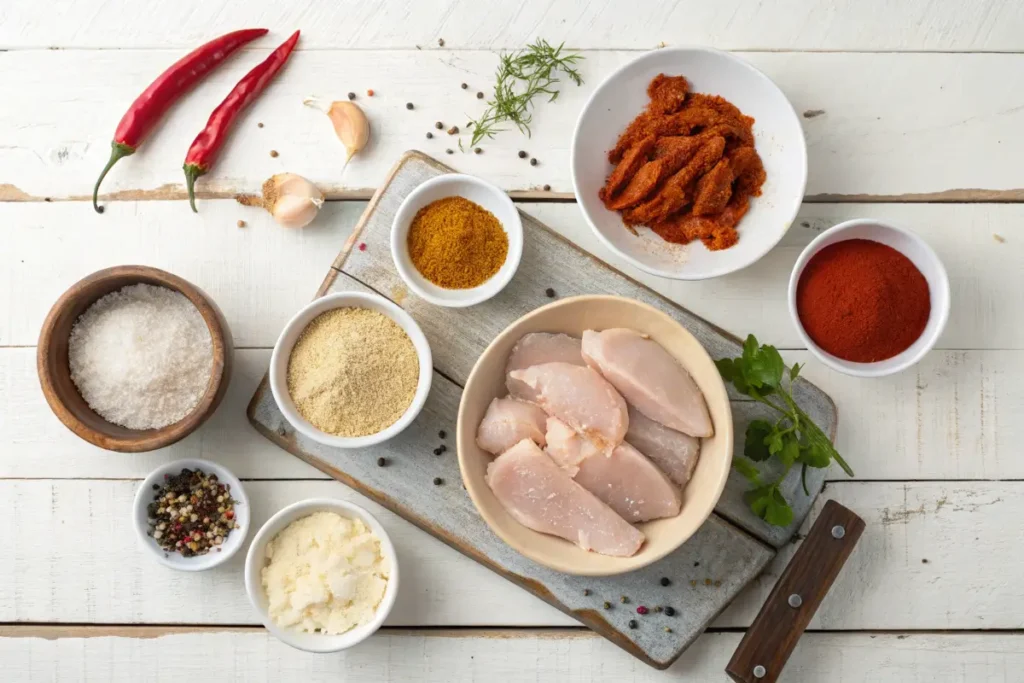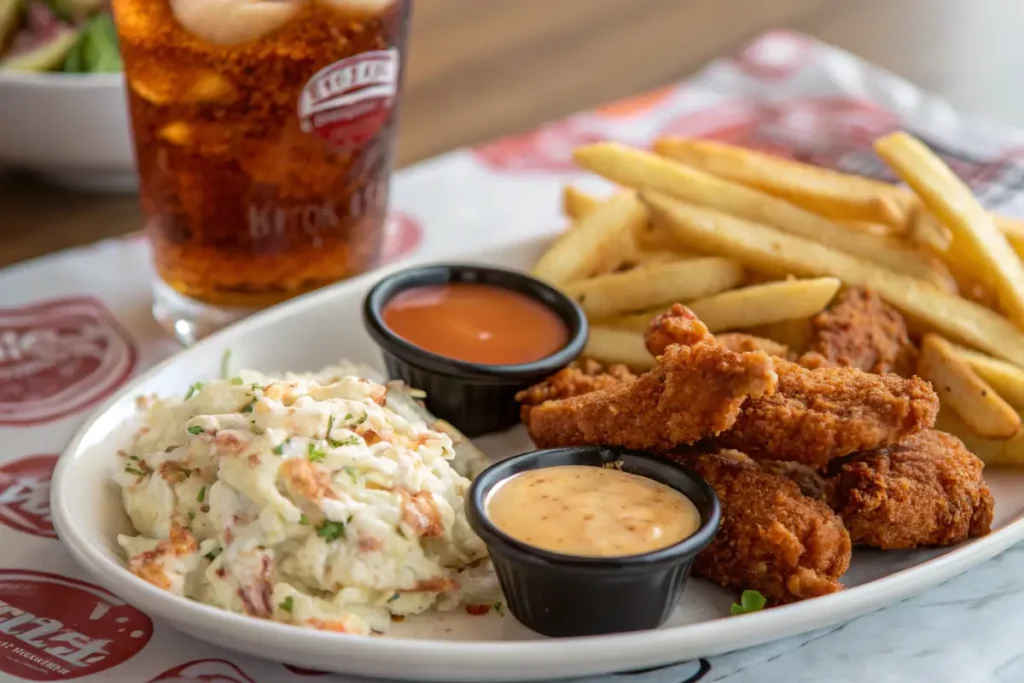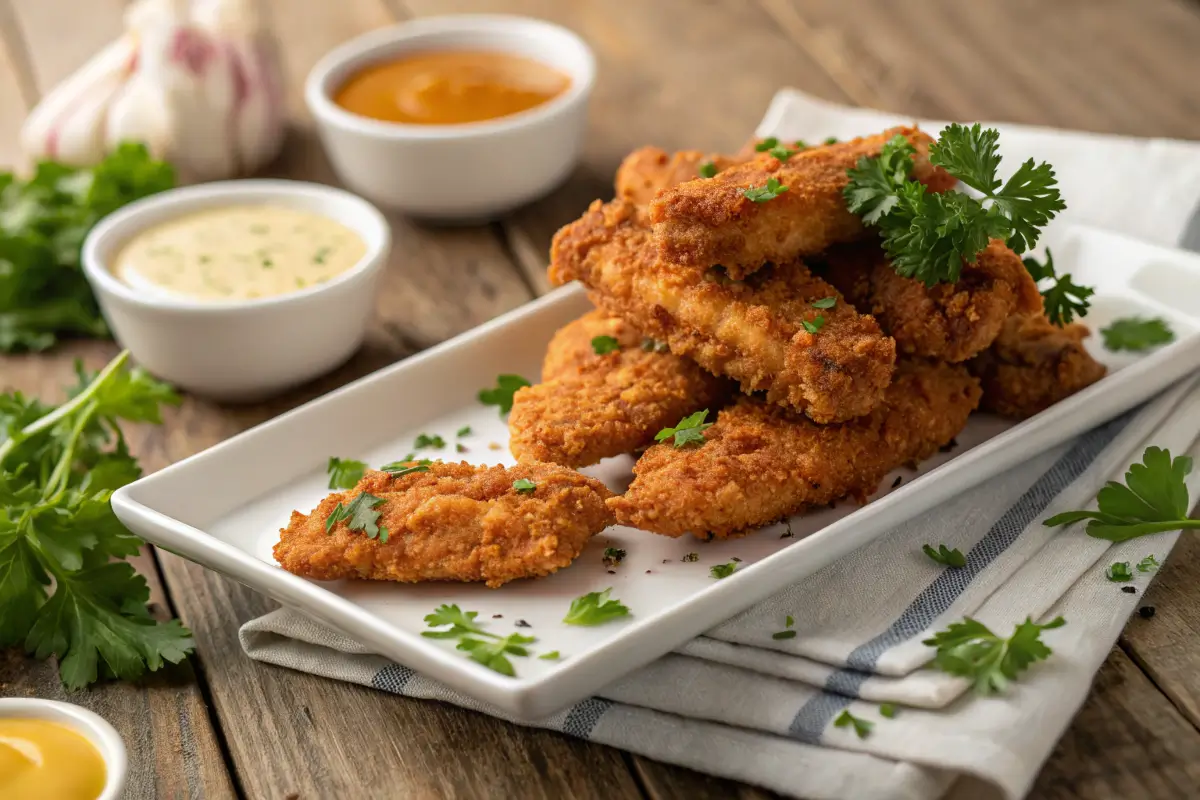When it comes to comfort food with a fiery twist, spicy chicken tenders are hard to beat. These crispy, flavorful strips of chicken are loved for their perfect balance of heat and crunch, making them a favorite for game nights, quick dinners, or snack cravings. In this guide, we’ll dive deep into the world of spicy chicken tenders, exploring their origins, recipes, cooking techniques, and serving ideas. Whether you’re a fan of Nashville hot chicken or looking for a healthier air-fried version, this guide has you covered.
Let’s kick things off with a closer look at what makes spicy chicken tenders so irresistible.
Table of contents
- Introduction to Spicy Chicken Tenders
- History and Origins of Spicy Chicken Dishes
- Key Ingredients for Perfect Spicy Chicken Tenders
- Cooking Methods: Achieving the Ideal Texture and Flavor
- Popular Spicy Chicken Tender Recipes
- Serving Suggestions and Pairings
- Health Considerations and Alternatives
- Frequently Asked Questions
- Conclusion: Embracing the Spice
Introduction to Spicy Chicken Tenders
The Popularity of Spicy Chicken Tenders
Spicy chicken tenders have taken the culinary world by storm. They’re a versatile dish that appeals to spice lovers and chicken enthusiasts alike. Perfect for everything from casual snacking to party platters, their crunchy texture and fiery flavor offer a satisfying bite every time. No wonder restaurants and fast-food chains have added their spin on this classic comfort food.
These fiery bites aren’t just for dining out, though. Home cooks are experimenting with spices and techniques to recreate restaurant-quality tenders in their kitchens. With endless ways to customize the heat level and flavor profile, spicy chicken tenders cater to every palate.
What Defines a Spicy Chicken Tender?
At its core, a spicy chicken tender is a boneless strip of chicken breast coated in a well-seasoned batter or breading, fried or baked until golden and crispy. The magic lies in the spice blend, which can include ingredients like cayenne pepper, paprika, garlic powder, and even hot sauce. The goal? A tender, juicy interior wrapped in a spicy, crunchy shell.
Whether served with dipping sauces like honey mustard or paired with sides like crispy fries, these tenders deliver a punch of flavor that leaves you wanting more. It’s this unbeatable combination of taste and texture that makes spicy chicken tenders a crowd-pleaser.
Stay tuned as we explore their rich history and global appeal in the next section!
History and Origins of Spicy Chicken Dishes
The Evolution of Spicy Fried Chicken
The story of spicy chicken begins in the southern United States, where fried chicken became a staple of comfort food. But what about the heat? Nashville hot chicken paved the way for today’s spicy chicken tenders. Legend has it that this fiery dish was created as a playful revenge meal, but its bold flavors quickly won people over.
Over the years, fried chicken evolved from a simple crispy treat to a dish packed with complex spice blends. Adding cayenne pepper, paprika, and other fiery ingredients turned classic fried chicken into a spicy sensation. This transformation laid the groundwork for the spicy chicken tenders we know and love.
Regional Variations: From Nashville Hot Chicken to Global Inspirations
While Nashville hot chicken is perhaps the most famous spicy variation, other regions have embraced the idea of spicing up their chicken. In Louisiana, Cajun spices are often used to create zesty and smoky flavors. Across the globe, countries like Korea have contributed their own twist with Korean spicy chicken tenders, marinated in gochujang for a sweet and spicy kick.
These regional takes on spicy chicken inspired home cooks to experiment with their own blends, leading to a wave of creative recipes. Whether it’s a mild heat or an intense fiery flavor, the global love for spicy chicken dishes continues to grow.
Key Ingredients for Perfect Spicy Chicken Tenders
Selecting the Right Chicken Cuts
The foundation of any great spicy chicken tender is quality chicken. Tenderloins are the most popular choice because they’re lean, easy to cook, and naturally juicy. However, thinly sliced chicken breasts can also work well. The key is to ensure uniform size so that all tenders cook evenly.
Fresh chicken is always best, as it holds onto marinades and breading better than frozen alternatives. When time is short, pat frozen chicken dry before starting the preparation process.
Essential Spices and Marinades
The spice mix is where the magic happens. A classic blend includes cayenne pepper, smoked paprika, garlic powder, onion powder, and black pepper. For an extra layer of heat, some recipes call for chili powder or a dash of hot sauce.
Marinades, often made with buttermilk, not only tenderize the chicken but also help the spices cling better to the surface. Adding hot sauce or chili paste to the marinade can give the chicken its first spicy kick before breading.
Breading and Coating Techniques
The breading is what makes spicy chicken tenders crispy and golden. A three-step coating process works best: dredging the chicken in flour, dipping it in an egg wash, and coating it in seasoned breadcrumbs or a flour mix.
To amp up the heat, spices can be added to both the flour and breadcrumb mixtures. Don’t forget to let the coated chicken rest for a few minutes before cooking. This step helps the breading stick and creates a crunchier crust.

Up next: Let’s talk about the best cooking methods to get that perfect balance of heat, crispiness, and flavor!
Cooking Methods: Achieving the Ideal Texture and Flavor
Deep-Frying vs. Oven-Baking
When it comes to cooking spicy chicken tenders, choosing between deep-frying and oven-baking can significantly impact the final result. Deep-frying delivers an undeniably crispy exterior, sealing in the juices for a tender bite. However, it involves submerging the tenders in hot oil, which can add extra calories and fat.
On the other hand, oven-baking offers a healthier alternative without sacrificing too much on texture. By placing the breaded tenders on a wire rack over a baking sheet and lightly spraying them with cooking oil, you can achieve a satisfying crunch. Baking at a high temperature, around 425°F (220°C), ensures the chicken cooks through while the coating turns golden brown.
Air-Frying: A Healthier Alternative
For those seeking a balance between health and crispiness, air-frying spicy chicken tenders is an excellent option. Air fryers circulate hot air around the food, creating a crispy layer with minimal oil. Preheat the air fryer to 400°F (200°C), arrange the tenders in a single layer, and cook for about 10-12 minutes, flipping halfway through. This method reduces oil intake while still delivering a delightful crunch.
Tips for Maintaining Juiciness and Crispiness
To keep your spicy chicken tenders juicy and crispy, consider the following tips:
- Marinate Properly: Allow the chicken to marinate for at least 30 minutes. This step enhances flavor and tenderness.
- Avoid Overcrowding: Whether frying or baking, ensure the tenders are arranged in a single layer with space between them. Overcrowding can lead to uneven cooking and sogginess.
- Monitor Cooking Time: Overcooking can dry out the chicken, while undercooking poses health risks. Use a meat thermometer to check that the internal temperature reaches 165°F (74°C).

By selecting the appropriate cooking method and following these tips, you can enjoy spicy chicken tenders that are both flavorful and satisfying.
Popular Spicy Chicken Tender Recipes
Classic Nashville Hot Chicken Tenders
Nashville hot chicken tenders are a fiery favorite known for their intense heat and rich flavor. To prepare this dish:
- Marinate: Soak the chicken tenders in a buttermilk and hot sauce mixture for at least an hour.
- Breading: Dredge the marinated chicken in a seasoned flour mixture containing cayenne pepper, paprika, and garlic powder.
- Frying: Deep-fry the tenders until golden brown and crispy.
- Spicy Coating: Immediately after frying, brush the tenders with a spicy oil blend made from cayenne pepper, brown sugar, and melted butter.
Serve these tenders with pickles and white bread to balance the heat.
Korean-Inspired Spicy Chicken Tenders
For a sweet and spicy twist, try Korean-style spicy chicken tenders:
- Marinate: Coat the chicken in a mixture of gochujang (Korean red pepper paste), soy sauce, minced garlic, and ginger. Let it sit for at least 30 minutes.
- Breading: Toss the marinated chicken in cornstarch for a light, crispy coating.
- Frying: Deep-fry or air-fry the tenders until crispy.
- Sauce: Prepare a sauce with gochujang, honey, soy sauce, and sesame oil. Toss the cooked tenders in the sauce until well coated.
Garnish with sesame seeds and chopped green onions before serving.
Buttermilk-Marinated Spicy Tenders
Buttermilk-marinated spicy chicken tenders are known for their tenderness and flavorful kick:
- Marinate: Soak the chicken in a buttermilk mixture with hot sauce, garlic powder, and onion powder for at least 2 hours or overnight.
- Breading: Combine flour with cayenne pepper, smoked paprika, and black pepper. Dredge the marinated chicken in the flour mixture.
- Cooking: Bake in a preheated oven at 425°F (220°C) for 20-25 minutes, flipping halfway through, or deep-fry until golden brown.
These tenders pair well with a cooling ranch or blue cheese dipping sauce.
Serving Suggestions and Pairings
Dipping Sauces: From Honey Mustard to Ranch
Spicy chicken tenders are fantastic on their own, but the right dipping sauce can elevate their flavor even more. Sweet, tangy, or creamy dips help balance the heat while adding an extra layer of taste. Classic choices like ranch and honey mustard are always a hit, but why not try something new?
- Spicy Mayo: Mix mayonnaise with sriracha for a creamy and spicy dip.
- Garlic Parmesan Sauce: A buttery, cheesy option that pairs perfectly with crispy tenders.
- Honey Sriracha Glaze: Sweet and spicy, this glaze is ideal for fans of bold flavors.
The variety of sauces available means you can experiment and find the perfect complement to your spicy chicken tenders.
Side Dishes: Coleslaw, Fries, and Beyond
No meal is complete without some tasty sides. Coleslaw is a traditional pairing that adds a refreshing crunch and cools the palate. Crinkle-cut fries or sweet potato fries are also popular options, providing a salty or sweet contrast to the tenders’ heat.
Looking for something different? Try:
- Mac and Cheese: The creamy, cheesy texture balances the spiciness.
- Roasted Vegetables: A healthy, flavorful option that adds color to your plate.
- Cornbread: A slightly sweet and soft side to complement the crunch of the tenders.
Incorporating Tenders into Salads and Sandwiches
Spicy chicken tenders aren’t just a standalone snack—they can be the star of many dishes. Add sliced tenders to a salad with mixed greens, cherry tomatoes, and a drizzle of ranch dressing for a hearty, spicy twist. Or, use them to build a sandwich with toasted bread, lettuce, and pickles. These versatile tenders make any meal more exciting.

Health Considerations and Alternatives
Nutritional Profile of Spicy Chicken Tenders
While spicy chicken tenders are delicious, they’re not always the healthiest option. Deep-frying adds extra calories and fat, but understanding the nutritional profile can help you make smarter choices. A typical serving of fried chicken tenders contains protein, fats, and carbs, but also sodium and cholesterol.
Luckily, you can reduce the calorie count by opting for baked or air-fried versions without compromising taste or texture. Choosing lean chicken breast and lighter breading options also makes a difference.
Baking and Grilling: Lower-Calorie Options
For a healthier take, baking and grilling are great alternatives. Baking requires minimal oil while still delivering crispiness. You can also grill spicy chicken tenders for a smoky flavor without the added fat from frying.
To enhance flavor, marinate the tenders with spices and a splash of lime juice before grilling. This method cuts down on calories while keeping the chicken tender and flavorful.
Plant-Based and Gluten-Free Variations
Spicy chicken doesn’t have to be limited to traditional recipes. Plant-based versions made with tofu or jackfruit are excellent for vegetarians and vegans. Coat these alternatives with the same spicy batter and bake or fry them to recreate the texture of tenders.
For those avoiding gluten, use gluten-free breadcrumbs or almond flour for breading. These swaps let everyone enjoy the spicy, crispy goodness without sacrificing dietary needs.
By tweaking recipes and cooking methods, spicy chicken tenders can fit into almost any lifestyle!
Frequently Asked Questions
What is the fancy name for chicken tenders?
The fancy name for chicken tenders is chicken goujons or chicken fillets. In culinary terms, they may also be called poultry strips or tenderloins, referring to the specific part of the chicken used.
What is the slang term for chicken tenders?
A popular slang term for chicken tenders is chicken fingers. Other playful terms include tendies or strips, commonly used in casual conversations or online.
Is blackened chicken tenders spicy?
Blackened chicken tenders are not inherently spicy, but they often carry a bold flavor due to the seasoning. The blackening process involves coating the chicken with a mix of spices like paprika, cayenne, garlic powder, and thyme, which gives it a smoky and slightly spicy kick. However, the heat level can vary depending on the recipe.
Does blackened mean spicy?
Not necessarily. Blackened refers to a cooking technique where the food is coated in a blend of spices and seared at high heat, creating a charred crust. While the seasoning mix often includes spices like cayenne or chili powder, the level of spiciness depends on the specific blend used.
Do Popeyes tenders come spicy?
Yes, Popeyes offers spicy chicken tenders as a menu option. These tenders are marinated in a spicy blend of seasonings, giving them a flavorful heat. If you prefer less spice, they also have mild versions available.

Conclusion: Embracing the Spice
Spicy chicken tenders are a flavorful, versatile dish that offers something for everyone. Whether you prefer a mild heat or crave bold, fiery flavors, these tenders can be customized to suit your taste. From classic Nashville-style tenders to plant-based variations, the possibilities are endless. With so many ways to serve and enjoy them—paired with dipping sauces, sides, or as part of a hearty sandwich—spicy chicken tenders are sure to be a hit at any table.
So, gather your ingredients, turn up the heat, and create your perfect batch of crispy, spicy tenders. Let your taste buds savor every bite!


3 thoughts on “The Ultimate Guide to Spicy Chicken Tenders”